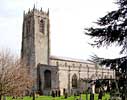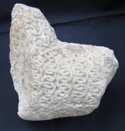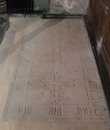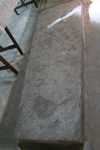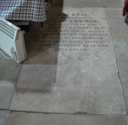For this church:    |
|
| Orate pro aia dni johanis albarne quoda vicarii de [Blida qui o]bit II vi III mens Ao dni mmo CCCC L XX VI. |
(Pray for the soul of Master John Albarne late vicar of Blyth who died 2nd of March AD 1476)
John Albarne was vicar of Blyth from 1466-76.
Nave North Arcade
1 Between
piers 2 and 3 from the east. Purbeck marble tapered slab with moulded edge
and abraded relief carving of a stemmed cross with trefoil ended arms, only
two of which survive. No eBottomvidence for a base.
Between
piers 2 and 3 from the east. Purbeck marble tapered slab with moulded edge
and abraded relief carving of a stemmed cross with trefoil ended arms, only
two of which survive. No eBottomvidence for a base.
Under Tower
1 Freestone
slab of foliated cross with inscription from c1300. The top of the
slab is missing, and only the lower edges of the foliate cross and its tapered
stem with a knob and stepped base still present. Sword on right of cross
shaft extends from knob on shaft to base, and has a prominent fuller (centre
groove), but the broad blade suggests that it is later than the slab. Inscription
on left side arranged vertically:
Freestone
slab of foliated cross with inscription from c1300. The top of the
slab is missing, and only the lower edges of the foliate cross and its tapered
stem with a knob and stepped base still present. Sword on right of cross
shaft extends from knob on shaft to base, and has a prominent fuller (centre
groove), but the broad blade suggests that it is later than the slab. Inscription
on left side arranged vertically:
| + ISSI: GIST : PERIS: DE: REWE: FRANKE: RCHANT: DE: BOSAS: |
(Here lies Peris de Rewe merchant of Bosa)
broken across by ‘RCHANT’ and repaired leaving a small section of the inscription missing. Bosa is a small town on the river Temo, close to the coast of western Sardinia in the Mediterranean.
2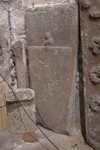 Purbeck
slab with shield in relief behind which can be seen the pommel of a sword
gripped by a human hand which is abraded. No blazon on the shield. The
lower part of the slab is broken off just below the bottom of the shield.
The slab can be seen in Hodges’s section drawing of the church published
in 1881 when it was in better condition and the tip of the sword was visible
beneath the shield. Abrasion to top of slab and surface worn.
Purbeck
slab with shield in relief behind which can be seen the pommel of a sword
gripped by a human hand which is abraded. No blazon on the shield. The
lower part of the slab is broken off just below the bottom of the shield.
The slab can be seen in Hodges’s section drawing of the church published
in 1881 when it was in better condition and the tip of the sword was visible
beneath the shield. Abrasion to top of slab and surface worn.
3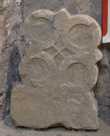 Freestone
foliated cross head of four broad, flat rings set against a lozenge with
the lower angle and lower edges of two rings not fully carved. In the centre
is a saltire cross in relief and there are cut-outs in line with it on
the rings. The block to which it is attached is broken and it is possible
that this is an unfinished piece. All the surfaces are heavily tooled.
There is no inscription.
Freestone
foliated cross head of four broad, flat rings set against a lozenge with
the lower angle and lower edges of two rings not fully carved. In the centre
is a saltire cross in relief and there are cut-outs in line with it on
the rings. The block to which it is attached is broken and it is possible
that this is an unfinished piece. All the surfaces are heavily tooled.
There is no inscription.
4 Tapered
Purbeck slab with, inside an incised border, a relief carving of a foliate
cross, a combination of the heraldic cross patonce with the cross recercelée,
having a hollow centre in which there is a narrow cross in relief. Stem
with three tiers of stiff-leaf foliage and an unusual curved base. Surfaces
abraded but once of high quality. Found in the mid 19th century buried
face down in the floor, re-used as paving.
Tapered
Purbeck slab with, inside an incised border, a relief carving of a foliate
cross, a combination of the heraldic cross patonce with the cross recercelée,
having a hollow centre in which there is a narrow cross in relief. Stem
with three tiers of stiff-leaf foliage and an unusual curved base. Surfaces
abraded but once of high quality. Found in the mid 19th century buried
face down in the floor, re-used as paving.
Nave South Arcade
Freestone slab of inscribed foliate cross set in floor between piers 4 and 5 on the south, but almost totally worn away apart from the top and bottom ends, which are of a cross patonce with a small cross in the centre and an unusual traceried arch base.
Nave centre
1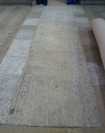 Rectangular
freestone floor slab trimmed at both ends and perhaps at one side with fragments
of incised lettering within a border along one long side. Too worn to be
deciphered.
Rectangular
freestone floor slab trimmed at both ends and perhaps at one side with fragments
of incised lettering within a border along one long side. Too worn to be
deciphered.
Above Nave vault
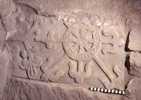 Foliated
cross slab, used as part of the rubble-fill on the top of the web at the
west end of the nave vault, found January 2003. Freestone, incomplete, probably
a waster. Relief design. At the top is a cross head of eight arms which end
in fleurs de lys, surmounted by a circle ornamented with billet. The stem
has two tiers of foliage branching from it. Early 13th-century date. Broken
off at the lower end and upper edge damaged. No inscription visible.
Foliated
cross slab, used as part of the rubble-fill on the top of the web at the
west end of the nave vault, found January 2003. Freestone, incomplete, probably
a waster. Relief design. At the top is a cross head of eight arms which end
in fleurs de lys, surmounted by a circle ornamented with billet. The stem
has two tiers of foliage branching from it. Early 13th-century date. Broken
off at the lower end and upper edge damaged. No inscription visible.
Post-medieval Monuments
Note that, where appropriate, some individual monuments are also included as War Memorials.
Nave north aisle
1
 |
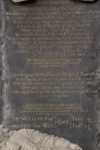 |
Edward Mellish, d1703, Wall monument with the figure reclining on one elbow on a tomb chest beneath an aedicule of Corinthian pilasters supporting a segmental pediment with curtains suspended from the entablature and looped up. Cartouche with arms above, quarterly of four, 1st and 4th, [azure] two swans in pale [argent] between two flaunches ermine (Mellish), 2nd and 3rd [gules] a lion rampant [or] between four crosses patonce [vair], (Reason). Edward Mellish died unmarried and the arms record his descent from William Reason of Askham (Notts) one of whose heirs was Edward’s grandmother, Alice. The inscription on the rear panel refers to its setting up by Edward’s nephew and heir and includes memorials to several others buried at Blyth. The others are, William Reason of Askham, d. 1628; Joan, widow of Samuel Mellish, who died in January 1708 (therefore 1709); Joseph Mellish, d. 1733, and Dorothy d. January 1737 (1738); Catherine, wife of William Mellish, d. 1746. Signed by John Hancock (fl. 1703-18, probably from York, the earliest of three monuments by him) on the top of the right hand side of the pediment. Painted inscription added to lower right corner:
| This monument was moved from over the vault AD 1885 |
The monument was originally sited in the centre of the east wall of the nave and moved during the restoration of 1885.
Inscription:
Here lyeth Interred
THIS monumt: is erected to his memory  Joan the pious Relict of Samuel Mellish of Doncaster  William Reason of Askham in this County Esqr:
|
| Catherine the Wife of Wm. Mellish Esq Died March 19th 1746 Aged 37 |
2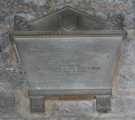 Freestone
wall monument to Rev John Rudd, d1834, by Joseph Lockwood of Doncaster
(1757-1837), a monument designer who specialised in neo-Hellenic designs.
One of 13 monuments by this sculptor and the only one in the county, the
rest are in South Yorkshire with two in Lincolnshire. Monument shaped like
the end of a Classical sarcophagus with sloped sides, supported on brackets,
with acroteria and shield on triangular pediment. Arms [argent] on a canton
[azure] six martlets [or], (Rudd), impaling [ermine] on a bend cotised [gules]
between a cross moline [azure] and an anchor [sable] three horseshoes [or],
(Ferris, Dean of Battle).
Freestone
wall monument to Rev John Rudd, d1834, by Joseph Lockwood of Doncaster
(1757-1837), a monument designer who specialised in neo-Hellenic designs.
One of 13 monuments by this sculptor and the only one in the county, the
rest are in South Yorkshire with two in Lincolnshire. Monument shaped like
the end of a Classical sarcophagus with sloped sides, supported on brackets,
with acroteria and shield on triangular pediment. Arms [argent] on a canton
[azure] six martlets [or], (Rudd), impaling [ermine] on a bend cotised [gules]
between a cross moline [azure] and an anchor [sable] three horseshoes [or],
(Ferris, Dean of Battle).
Inscription:
SACRED  ISABELLA 4TH. DAUGHTER OF THE REVD.
J. RUDD  ELIZABETH |
3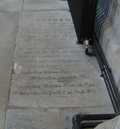 Inscribed
freestone floor slab to the daughters of Rev. John Raine, Jane Anne Raine, d1841;
Francisca Elizabeth Raine, d1850; Isabella Raine, d1852;
and Augusta Raine, d1856(?).
Inscribed
freestone floor slab to the daughters of Rev. John Raine, Jane Anne Raine, d1841;
Francisca Elizabeth Raine, d1850; Isabella Raine, d1852;
and Augusta Raine, d1856(?).
Inscription:
SACRED  Francisca Elizabeth Raine "Illa ut audivit surgit  Isabella Raine Nat: v: Cal: Ma [..]  Augusta Raine Nat: iv: [.]on: Di |
Illa ut audivit surgit cito et venit ad eum (When she heard it, she rose quickly and went to him) is from John 11.29.
4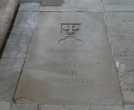 Freestone
floor slab, with cross patonce sunk in relief on a shield. Inscribed with
initials and dates of 1834, 1837 and 1858.
Freestone
floor slab, with cross patonce sunk in relief on a shield. Inscribed with
initials and dates of 1834, 1837 and 1858.
Inscription:
J, R.  Mdcccxxxiv. J, R. E, R. |
Under tower
 Stone
wall monument of an inscribed slab under an ornamented urn on a draped pedestal,
the whole set against a flat, shaped panel supported by a sill with end pieces.
Memorial to Robert Spencer , d1800.
Stone
wall monument of an inscribed slab under an ornamented urn on a draped pedestal,
the whole set against a flat, shaped panel supported by a sill with end pieces.
Memorial to Robert Spencer , d1800.
Inscription:
| SACRED to the Memory of MR. ROBERT SPENCER, late of Hodsock in this County, who departed this Life August 19th. 1800, aged 27 Years. |
Nave South Arcade
1
 |
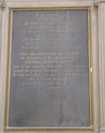 |
Attached to pier 5 from the east. Catherine Hornby, d1772 wall tablet signed by J. Wood, identified as Joseph Wood (fl 1766-c1776), the master mason responsible for rebuilding Thoresby Park for the Duke of Kingston between 1766-9 under the York architect John Carr (since rebuilt by Anthony Salvin). This is the only monument known by Wood, and his association with John Carr, who was a personal friend of William Mellish and worked on Blyth Hall in 1773-6, may have been connected with its commissioning. Large architectural tablet of an inscribed panel within a frame of Ionic pilasters supporting a plain entablature surmounted by an urn with swags between two flaming torches. Lower section of a winged putto head within a circle against a cross and an anchor between consoles.
Inscription:
To the Memory of In her Life, she was greatly beloved, Born October 15th. 1738, Died April 11th. 1772.  Near this Monument are deposited THOMAS JUDSON GENT. who to an extensive Knowledge of Business, |
2 Attached
to pier 6 from the east. Robert Spencer, d1794, wall tablet with
inscribed marble slab set against a black stone panel with a small urn on
the curved pediment.
Attached
to pier 6 from the east. Robert Spencer, d1794, wall tablet with
inscribed marble slab set against a black stone panel with a small urn on
the curved pediment.
Inscription:
NEAR ALSO |
Nave West End
1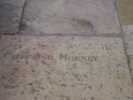 At
the base of pier 5 from the east. Inscribed freestone floor slab, with inscription
At
the base of pier 5 from the east. Inscribed freestone floor slab, with inscription
| CATHERINE HORNBY |
but originally a rectangular medieval inscribed slab with a fragment of lettering within a border, not decipherable.
2Between south arcade piers 5 and 6 from the east. Inscribed floor slab, under an inscribed semi-circular head, to Elisabeth Hieron, d171[..]. Partially worn away on the right side.
Inscription:
HERE She departed .... |
William Hieron was vicar of Blyth from 1694 and had ceased to be by 1731.
3Next to south arcade pier 6 from the east, inscribed freestone floor slab to Thomas Spencer, d. 1750.
Inscription:
| HERE Resteth in hopes of a glorious resur rection the Body of Thomas Spencer the son of Robert Spencer of Hodsack in the Parish Gent who de parted this Life on saturday February the 17th Anno Dom. 1750 in the 18th year of his AGE |
4Beside no. 3 and probably by the same mason. Inscribed freestone floor slab to Robert Spencer, d1765.
| HERE Resteth in hopes of a glorious resurrection the Body of Robert Spencer late of Hod sack in this Parish Gent who departed this Life on saturday Ianuary 25th Anno Dom 1765 in the 63rd. year of his AGE |
5Beside no. 4, inscribed floor slab, almost entirely worn away, to wife of Robert Spencer.
Inscription:
| .......................the Body of................wife of Robert
Spencer ......................in this Parish...........who departed this life............................ Anno Dom..................in th... ............of........ |
6To the west of no. 5, inscribed floor slab, almost worn away, to Dorothy Spencer, and another member of the same family.
Inscription:
| ............................Dorothy Spencer ....................Wife................... ................Oct 22nd. ......................Years............... |
7Next to no. 6, inscribed floor slab, almost worn away, to Harriet? Spencer, d. 1800.
Inscription:
| HERE .............th[e] ...B[o]dy of [HA]RRI[ET] SPE[NCE]R ................1800 |
8West of no. 7, inscribed floor slab, badly worn, to Robert Spencer, d. 1800.
Inscription:
HERE He departed this Life |
9Close to font, inscribed freestone floor slab to Rev John Beel, d. 1762.
Inscription:
| The Revd. John Beel A.B. died the 4th. of July 1762 aged 58 Years |
There is no reference to a Rev Beel in the list of 18th-century vicars of Blyth.
South Aisle Monuments
1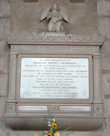 On
the rear of pier 3 of the south arcade. Charles Henry Chambers, d1840,
wall monument of an inscribed marble slab within a frame of Tuscan pilasters
with a panelled entablature and jewelled bases. It is surmounted by a frieze
of acroteria fronted by masks behind which is a kneeling angel holding
a shield on which is a star.
On
the rear of pier 3 of the south arcade. Charles Henry Chambers, d1840,
wall monument of an inscribed marble slab within a frame of Tuscan pilasters
with a panelled entablature and jewelled bases. It is surmounted by a frieze
of acroteria fronted by masks behind which is a kneeling angel holding
a shield on which is a star.
Inscription:
IN FOND REMEMBRANCE OF AND SO WAS HIS BROTHER |
| THEIR MOTHER OUTLIVED THEM | DYING AUGUST 12TH. 1855 AGED 74 |
2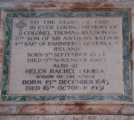 Attached
to the south wall in the east bay. Inscribed marble slab framed with painted
frieze of shamrocks and an alabaster moulding, to Col. Thomas Weldon, d.
1905.
Attached
to the south wall in the east bay. Inscribed marble slab framed with painted
frieze of shamrocks and an alabaster moulding, to Col. Thomas Weldon, d.
1905.
Inscription:
TO THE GLORY OF GOD BORN 9TH SEPTEMBER 1834 ALSO OF |
3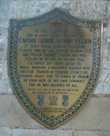 Beneath no.
2, on a brass plaque in the shape of a shield, with a decorated border
of a frieze of shamrocks, and images of two medals flanking the crest of
the Weldon family, the bust of Queen Elizabeth Ist, with the motto, BENE
FACTUM, in the base, memorial to Captain George Weldon, d1899.
Black script with red capital letters.
Beneath no.
2, on a brass plaque in the shape of a shield, with a decorated border
of a frieze of shamrocks, and images of two medals flanking the crest of
the Weldon family, the bust of Queen Elizabeth Ist, with the motto, BENE
FACTUM, in the base, memorial to Captain George Weldon, d1899.
Black script with red capital letters.
Inscription:
TO THE GLORY OF GOD KILLED IN ACTION ON TALANA HILL "Greater love hath no man than this, that a man  "He hath well done and so |
The wording of this memorial seems to have been confused and it is hard to know how to rearrange the lines to read correctly, but an alternative layout for the second part might be:
killed in action at Talana Hill, October 20th 1899, aged 33, while bringing a wounded soldier into shelter, under heavy fire. Buried in Dundee cemetery by four men of his own company, October 21st 1899, for he was beloved by all.
The Dundee cemetery mentioned is that in Natal, South Africa, not Scotland, with the battle of Talana Hill fought on October 20th 1899 during the Second Boer War. Talana was one of three hills overlooking Dundee and the 2nd battalion of the Royal Dublin Fusiliers led the attack on the hill but were held down by heavy fire from the Boers and only took the hill after fierce fighting. Captain Weldon was the first officer of the regiment to be killed in the Boer War, and had joined in 1886, being promoted to Captain in 1896. His body was apparently located after the battle by his dog. He was the eldest son of Col. Thomas Weldon (1834-1905) and Helen Rachel Louisa Young Simpson.
4Beneath no. 3, brass plaque with inscription in black lettering with red used for large capitals, recording the erection of no. 3 and certain windows in the church.
Inscription:
| The above Brass erected by his Father and Mother, by whom the Windows in the Church to May Sewell, daughter, General and MRS Young Simpson, Father and Mother, and Ellen Walker, cousin, were also erected. |
5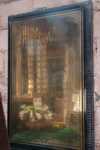 Bay
to west of screen, attached to the south wall. Brass wall monument to Lt.
Colonel Henry Francis Mellish, d1817, within an inscribed architectural
frame.
Bay
to west of screen, attached to the south wall. Brass wall monument to Lt.
Colonel Henry Francis Mellish, d1817, within an inscribed architectural
frame.
Inscription:
IN REMEMBRANCE OF HE SERVED AS AIDE-DE-CAMP TO HE DIED AT HODSOCK PRIORY  HE SERVED HIS COVNTRY AND LOVED HIS KIND |
The battle of Vimiero, Portugal, which took place on August 21st 1808, was one of the first battles of the Peninsular War (1808-1814), with the British forces successfully led by Sir Arthur Wellesley, later duke of Wellington. Sir Ronald Ferguson commanded the 2nd Brigade at Vimiero.
6 Brass
Gothic Revival wall monument, within an architectural frame with a cusped
arch under a triangular canopy with pinnacles and the IHS symbol flanked
by two encircled crosses patonce, which has a border around the edge with
the four evangelists' symbols identified by their names at the corners. To
William Leigh Mellish, d1864, signed on the lower edge Cox & Buckley
London. Inscription in Gothic black-letter script, with all capital letters
in red.
Brass
Gothic Revival wall monument, within an architectural frame with a cusped
arch under a triangular canopy with pinnacles and the IHS symbol flanked
by two encircled crosses patonce, which has a border around the edge with
the four evangelists' symbols identified by their names at the corners. To
William Leigh Mellish, d1864, signed on the lower edge Cox & Buckley
London. Inscription in Gothic black-letter script, with all capital letters
in red.
Inscription:
In memory of Also of his Widow |
The firm of Cox and Buckley, sometimes styled Cox, Son, Buckley & Co. was a London-based firm of brass engravers, that began as Cox & Son, a firm of metalworkers and stained glass makers. The firm merged with Buckley & Co. in 1881. It was extant from 1860-1893 when the firm experienced difficulties and went into receivership. They are then found in the US, working in New York in 1899 and in 1882 had made a memorial brass for the assassinated President James Garfield, to be installed in the Episcopal church at Elberon, Long Branch, New Jersey where he died, although he is not buried there. From the description in The New York Times of June 15th 1882 the brass closely resembles the Mellish one in its use of a Gothic canopy and black lettering with red capitals, although it is more elaborate.
7 Brass
wall monument to George Mellish, d1877, signed lower right edge,
Hart, Son, Peard & Co London.
Brass
wall monument to George Mellish, d1877, signed lower right edge,
Hart, Son, Peard & Co London.
Inscription:
IN MEMORY OF THE RIGHT HONOURABLE  “BEHOLD WE COUNT THEM HAPPY THAT ENDURE,” JAMES V:II |
Sir George was the son of Edward Mellish and his wife Elizabeth Leigh, who was related to George Canning, and had a career in the law at the Inner Temple in London, being made QC in 1861 and was appointed lord justice of appeal in chancery, knighted and made a member of the privy council in 1870. Although it was unusual to appoint a common-law practitioner to a senior position in chancery Mellish was very successful in the role. He is reported to have suffered badly from gout and died unmarried at his London house, 33 Lowndes Square in 1877.
The firm of Hart, Son, Peard & Co, artistic metalworkers, was based in London at 138, 140 Charing Cross Road, and at the Grosvenor Works in Birmingham, and was active between 1860 and the 1920s. Their London showroom was in Regent Street, and their production mostly consisted of brass wall plates and figured brasses. The architect William Butterfield worked for the firm in the 1870s. One of their brasses, to a Lord Mayor of London, George Swan Nottage, who died 1885, is in the crypt of St Paul's cathedral in London, and another notable brass is to the artist William Dyce (d1864).
8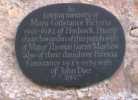 Beneath no. 7. Engraved
black stone, to Mary Mayhew, d. 1982
Beneath no. 7. Engraved
black stone, to Mary Mayhew, d. 1982
Inscription:
| In Loving memory of Mary Constance Victoria 1901 - 1982 of Hodsock Priory churchwarden of this parish, wife of Major Thomas Garret Mayhew also of their daughter Patricia Constance 1923 - 1979, wife of John Dyer DFC |
9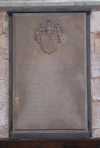 Stone
wall monument with arms, in relief, at top Mellish quartering (gules) a cross
engrailed (argent), in dexter chief an escutcheon charged with two bars (azure)
overall a bend componée
(argent and gules) (Leigh). Crest Mellish, with mantling. To Henry Mellish,
d1927, Agnes Mellish, d1934 and Evelyn Mellish, d1935.
Stone
wall monument with arms, in relief, at top Mellish quartering (gules) a cross
engrailed (argent), in dexter chief an escutcheon charged with two bars (azure)
overall a bend componée
(argent and gules) (Leigh). Crest Mellish, with mantling. To Henry Mellish,
d1927, Agnes Mellish, d1934 and Evelyn Mellish, d1935.
Inscription:
TO THE MEMORY OF HE UNSPARINGLY GAVE HIMSELF TO  AND OF HIS SISTERS EVELYN FRANCES MELLISH THEY DEVOTED THEMSELVES TO THE |
10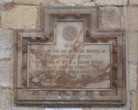 Alabaster panel within a border, having
a stepped top with a circular badge of a lion rampant against a saltire cross
with an inscription in relief LONDON SCOTTISH, STRIKE SURE, the regimental
badge of the London Scottish regiment. To Percy Crofts Ottley, d1917.
Alabaster panel within a border, having
a stepped top with a circular badge of a lion rampant against a saltire cross
with an inscription in relief LONDON SCOTTISH, STRIKE SURE, the regimental
badge of the London Scottish regiment. To Percy Crofts Ottley, d1917.
Inscription:
| TO THE GLORY OF GOD AND IN LOVING MEMORY OF PERCY CROFTS OTTLEY, SECOND SON OF WM H. & JESSIE OTTLEY, OF RANSKILL GRANGE. WHO FELL IN ACTION NEAR CAMBRAI, FRANCE, NOV. 23RD 1917, AGED 32 YEARS. "GRANT HIM O LORD ETERNAL REST" |
The London Scottish was a Territorial regiment which provided three battalions during the Great War and lost 1,542 men during its course.
11Brass plate beneath the principal War Memorial. Memorial to John Moore, d1955.
Inscription:
| The UNION JACK was given in Loving Memory of JOHN MOORE who died Dec. 6th. 1955. Aged 34, as a direct result of disease contracted whilst serving with the RAF in INDIA during the SECOND WORLD WAR. |
12Copper inscribed plaque to Helen Patterson, d. 1950.
Inscription:
IN LOVING MEMORY OF DIED 12th. MAY 1950 |
Hatchments
Series of eight hatchments for the Mellish family, dated between 1733 and 1864.
1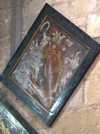 South aisle west wall, dexter background
black. Azure two swans in pale argent between two flaunches ermine (Mellish),
impaling, gules a fess between three crosses crosslet fitchée or (Gore).
Crest, a swan's head and neck erased argent, ducally gorged or (Mellish).
No motto. Mantling gules and argent.
South aisle west wall, dexter background
black. Azure two swans in pale argent between two flaunches ermine (Mellish),
impaling, gules a fess between three crosses crosslet fitchée or (Gore).
Crest, a swan's head and neck erased argent, ducally gorged or (Mellish).
No motto. Mantling gules and argent.
For Joseph Mellish, (d1733) m Dorothy Gore.
2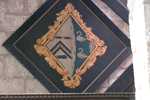 South aisle west wall, beneath no.
1. Whole background black. On a lozenge
within a gilt border. Argent, a chevron ermine fimbriated sable between three
chambers sable, fired proper (Chambers) impaling Mellish.
South aisle west wall, beneath no.
1. Whole background black. On a lozenge
within a gilt border. Argent, a chevron ermine fimbriated sable between three
chambers sable, fired proper (Chambers) impaling Mellish.
For Anne Mellish, (d1855) m William Chambers.
3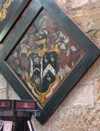 South aisle west wall, beneath no.
2. Dexter background black. Mellish,
with escutcheon of pretence, sable a chevron ermine between three herons
close argent (Herne), impaling Herne. Crest Mellish. No motto. Mantling
gules and argent.
South aisle west wall, beneath no.
2. Dexter background black. Mellish,
with escutcheon of pretence, sable a chevron ermine between three herons
close argent (Herne), impaling Herne. Crest Mellish. No motto. Mantling
gules and argent.
For Edward Mellish, (d1757) m Sarah Herne.
4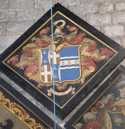 Tower north wall. Whole background black.
Quarterly of four, 1st and 4th Mellish, 2nd and 3rd, gules a cross engrailed
argent, in the dexter chief an escutcheon of the second charged with two
bars azure overall a bend componée
argent and gules (Leigh), impaling azure on a fess wavy cotised argent three
anchors sable (Cunard). Crest Mellish. No motto. Mantling gules and or.
Tower north wall. Whole background black.
Quarterly of four, 1st and 4th Mellish, 2nd and 3rd, gules a cross engrailed
argent, in the dexter chief an escutcheon of the second charged with two
bars azure overall a bend componée
argent and gules (Leigh), impaling azure on a fess wavy cotised argent three
anchors sable (Cunard). Crest Mellish. No motto. Mantling gules and or.
For Colonel William Leigh Mellish, (d1864) m Margaret Cunard.
5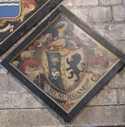 Tower north wall, beneath and east of no.
4. Dexter background black. Mellish
impaling argent a lion rampant sable langued gules (Stapleton). Crest Mellish.
Motto, Resurgam. Mantling gules and argent.
Tower north wall, beneath and east of no.
4. Dexter background black. Mellish
impaling argent a lion rampant sable langued gules (Stapleton). Crest Mellish.
Motto, Resurgam. Mantling gules and argent.
For Charles Mellish (d1797), m Judith Stapleton
6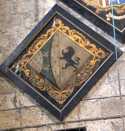 Tower north wall, and west of no.
5. Whole background black. On a lozenge
within a gilt border, Mellish impaling Stapleton. Motto, In Coelo Quies.
Tower north wall, and west of no.
5. Whole background black. On a lozenge
within a gilt border, Mellish impaling Stapleton. Motto, In Coelo Quies.
For Judith Stapleton (d1806), m Charles Mellish.
7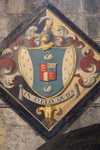 Tower west wall, south side. Dexter background
black. Mellish, with in pretence, quarterly, 1st and 4th, gules three lions
passant or (in error for argent), (Gifford), 2nd, per fesse argent and azure
three chaplets proper (in error for countercharged), (Duke), 3rd, per pale
embattled gules and argent (not identified). Crest Mellish. Motto, In Coelo
Quies. Mantling gules and argent.
Tower west wall, south side. Dexter background
black. Mellish, with in pretence, quarterly, 1st and 4th, gules three lions
passant or (in error for argent), (Gifford), 2nd, per fesse argent and azure
three chaplets proper (in error for countercharged), (Duke), 3rd, per pale
embattled gules and argent (not identified). Crest Mellish. Motto, In Coelo
Quies. Mantling gules and argent.
For Lt-Colonel Henry Francis Mellish (d1817), m Harriet, daughter of Sir Duke Gifford Bt.
8 Tower west wall, north side. Whole background
black. On a lozenge within a gilt border, sable three lions rampant argent,
langued gules, (Prowse), impaling to dexter, or a chevron engrailed between
three leopards' faces gules, (Harvey), and to sinister, Mellish, with mullet
pierced for difference.
Tower west wall, north side. Whole background
black. On a lozenge within a gilt border, sable three lions rampant argent,
langued gules, (Prowse), impaling to dexter, or a chevron engrailed between
three leopards' faces gules, (Harvey), and to sinister, Mellish, with mullet
pierced for difference.
For Joan Prowze (d1709), m 1st Tobias Harvey, 2nd Samuel Mellish (d1707). This is the earliest recorded hatchment in the county.


